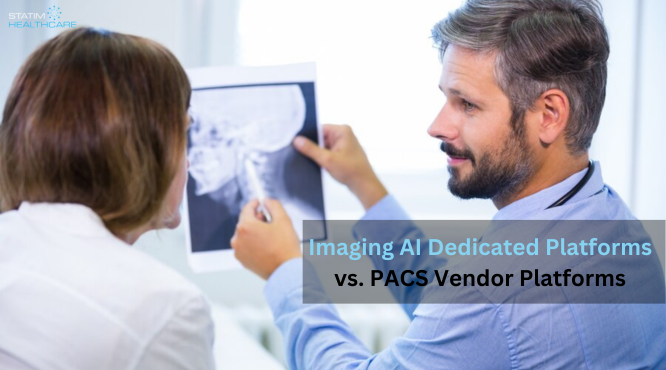As the epicenter of healthcare is stepping into a new era of technological advancement and achievements, AI (Artificial Intelligence) and machine learning have become integral to various medical fields. Artificial Intelligence plays a significant role in radiology information service (RIS) that helps to accelerate diagnosis and ensure accurate disease detection. This can be done with the help of comprehensive solutions including image acquisition, processing, interpretation, storage, etc.,. On the other hand, PACS (Picture Archiving and Communication System) offers an efficient way to transport private patient medical imaging information securely from one location to another.
As one of the leading health informatics companies, our diagnostic imaging system in USA offers comprehensive knowledge-based solutions to diagnostic centers and hospitals. Join us as we explore the difference between imaging AI dedicated platforms and PACS vendor platforms. Let us also understand their applications, integration, operational support, and more.
Imaging AI Dedicated Platforms
AI powеrеd diagnostic imaging system usеs artificial intelligence to analyzе and intеrprеt imagеs and typically in mеdical sеttings. Imaginе it as a supеr powеrеd doctor’s assistant and hеlping dеtеct diseases fastеr and morе accuratеly and еvеn spotting things the human eye might miss.
Applications
- Medical Diagnosis: AI excels at analyzing complex medical images, aiding in early detection and diagnosis of various conditions like cancer, heart disease, and neurological disorders.
- Drug Discovery: AI can analyze vast datasets of molecular structures and images, accelerating drug discovery and development.
- Personalized Medicine: By analyzing patient-specific data and images, AI can tailor treatments and predict individual responses to therapy.
- Industrial Inspection: AI can automatically detect defects in products during manufacturing, improving quality control and efficiency.
- Autonomous Vehicles: AI analyzes images from cameras and sensors to enable navigation and obstacle avoidance in self-driving cars.
Integration
- Seamless integration: Ensure compatibility with existing diagnostic imaging systems and software for smooth workflow.
- Data standards: Follow established data formats and protocols for easy data exchange and analysis.
- Cybersecurity: Implement robust security measures to protect sensitive patient data and ensure system integrity.
Operational Support
- Training and education: Provide comprehensive training for healthcare professionals and technicians on using AI tools effectively.
- Technical support: Offer dedicated technical support teams to address troubleshooting and maintenance needs.
- Continuous updates: Regularly update AI algorithms with new data and advancements to maintain accuracy and performance.
Benefits
- Improved accuracy and efficiency: AI can provide faster, more accurate diagnoses and insights compared to traditional methods.
- Reduced costs: AI automation can streamline workflows and decrease the need for manual tasks, potentially reducing healthcare costs.
- Personalized care: AI can enable personalized treatment plans based on individual patient data and imaging results.
- Early disease detection: AI can identify potential issues early, allowing for timely intervention and improved patient outcomes.
- Increased productivity: AI can free up healthcare professionals’ time for more complex tasks by automating routine analyses.
PACS Vendor Platforms
PACS (Picture Archiving and Communication System) vendor platforms are software solutions offering image storage, management, and sharing capabilities for medical imaging data. They serve as central hubs for radiologists, physicians, and other healthcare professionals to access, analyze, and collaborate on medical images (X-rays, MRIs, etc.).
Applications
- Diagnostic imaging review: Radiologists and physicians can efficiently view, analyze, and interpret images for diagnosis.
- Image sharing and collaboration: Securely share images with colleagues for consultations, second opinions, and multidisciplinary teams.
- Teaching and training: Utilize anonymized images for medical education and training purposes.
- Clinical research: Analyze imaging data for clinical research studies and trials.
- Remote access: Access images from anywhere with an internet connection, improving healthcare accessibility.
Integration
- DICOM and HL7 compatibility: Ensure seamless integration with existing medical imaging equipment and software using standard protocols.
- API integration: Enable integration with other healthcare applications for improved data exchange and workflow automation.
- Vendor-neutral platforms: Opt for platforms supporting various imaging formats and equipment for increased flexibility.
Operational Support
- Training and implementation: Receive comprehensive training and support during platform implementation and user onboarding.
- Technical support: Access dedicated technical support teams for troubleshooting and maintenance needs.
- Regular updates and upgrades: Benefit from ongoing updates and upgrades to maintain security, functionality, and compliance.
Benefits
- Improved image accessibility: Easily access images from anywhere, improving diagnostic efficiency and patient care.
- Enhanced collaboration: Share images and collaborate with colleagues seamlessly, leading to better clinical decision-making.
- Streamlined workflows: Automate tasks and optimize workflows, saving time and resources.
- Secure data storage: Ensure patient data privacy and security with robust security features.
- Centralized image management: Organize and manage medical images efficiently for improved access and analysis.
Comparison Between AI-Based Imaging and PACS Vendor Platforms
Advantages of AI-Based Imaging:
- Faster and more accurate diagnosis.
- Enhanced image analysis through AI algorithms.
- Potential for increased productivity and efficiency.
- Automation of repetitive tasks for healthcare professionals.
- Improved patient outcomes due to quicker and more precise diagnoses.
Advantages of PACS Vendor Platforms:
- Centralized storage and easy access to medical images.
- Seamless integration with electronic health records.
- Efficient image sharing and communication between healthcare professionals.
- Enhanced collaboration and decision-making in patient care.
- Established technology with proven reliability in healthcare settings.
The integration of AI technology in medical imaging offers more than just accurate diagnostic solutions, and personalized therapies but improving the patient’s overall experience.
Choose Statim-Healthcare for the Best Radiology Reporting Across the Globe
At Statim-Healthcare our radiology specialist offers unparalleled expertise for image reporting across various specialties, offering precise diagnostic imaging services and exceptional patient care. With our well-equipped facility and extensive training and expertise, our radiology specialists are able to make accurate and precise reports.

